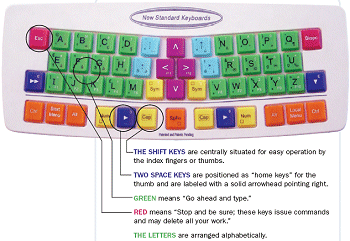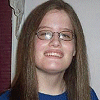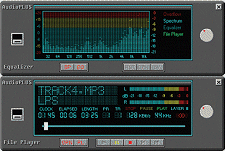Assistive Technology :: Making the Impossible Possible
##AUTHORSPLIT###- -->
Assistive technologies are helping students who don’t respond to conventional means of instruction, and in the process...
 A KEYBOARD THAT’S COLOR-CODED and arranged alphabetically. An audio book that lets users hear what they’re reading—at several speeds. A 21-inch wand that can be used to manipulate objects on an interactive whiteboard. A school that tailors its curriculum to individual modes of learning. These are glimpses of today’s world of assistive technology: hardware, software, and systems for students who can’t quite get by with the usual pedagogy. With each technologycomes numerous success stories. Here are a few that stand out.
A KEYBOARD THAT’S COLOR-CODED and arranged alphabetically. An audio book that lets users hear what they’re reading—at several speeds. A 21-inch wand that can be used to manipulate objects on an interactive whiteboard. A school that tailors its curriculum to individual modes of learning. These are glimpses of today’s world of assistive technology: hardware, software, and systems for students who can’t quite get by with the usual pedagogy. With each technologycomes numerous success stories. Here are a few that stand out.
“By using the keyboard, he doesn’t feel so out of it.”
Eight-year-old Kevin Hogan has been diagnosed with pervasive developmental delay, a mild form of autism. He also has dyslexia, sometimes hearing—in addition to seeing—words differently. He goes to public school in the morning and the HillSprings Learning Center in Colorado Springs, for students with learning disabilities, in the afternoon. For him, writing is a long, frustrating task; typing is hunt-and-peck.
Or rather it was. When Kevin’s mother, Diane, a former teacher, came across a local Colorado Springs newspaper article about different assistive technologies, a device called the New Standard Keyboard caught her eye, and she ordered one for her son. It has made a world of difference.
The New Standard Keyboard, produced by New Standard Keyboards in Santa Maria, CA, will look radically different to anyone trained on the traditional QWERTY (the first six letters of the top finger row) keyboard. The letters are arranged alphabetically and color-coded, which is meant to give students a better understanding of the different functions of the keys. For example, red means “Stop and be sure; these keys issue commands and could delete all your work.” Green means “Go ahead and type.”
Why is it considered a new standard keyboard? Ask John Parkinson, who designed it. He took a traditional typing class as preparation for writing a book and was frustrated with the old system—he kept looking back at the keyboard as he was composing. Finally, he decided that he could invent something better: a new standard. “It was designed,” he says, “to make typing easy for everybody—easy to learn and easy to do.”

KEYED IN: Its maker says the New Standard
Keyboard makes typing easy for everyone.
Parkinson sees the potential to serve users with a variety of needs. Seniors in particular, he says, have difficulty with tasks that rely on short-term memory for new learning and would benefit, and a colleague suggested that “this is just what they need at the VA hospital, where they have brain injuries and memory problems. They can learn on this because they already know the alphabet.” Plus, Parkinson has recently received correspondence from blind typists, who he says seem ideally suited for the new keyboard.
Diane Hogan says it took her son some time to get used to the new keyboard, but he gradually caught on. Whereas before, Kevin wouldn’t participate in writing activities, now he’s asking her to set him up with his own e-mail account. “It allows him more independence from me,” says Diane, who, interestingly, taught traditional keyboarding for more than 10 years.“We’re seeing him take more risks and be more successful.”
Diane bought a second New Standard Keyboard for Kevin to use at the learning center, while keeping the first one for use at home. The keyboard helps him in at least two ways. First, of course, is his academic work. And second is his self-image.“He’s cognizant of his deficiencies and has a lot of anxiety,”says Diane. “By using the keyboard, he doesn’t feel so out of it.”
Parkinson says that his next move is to put the keyboard into a laptop. People such as the Hogans have made quite an impression on him. “I had set out to make the difficult easy for lazy people like me,” he says, “and what I had done was make the impossible possible for someone who really needed it. There may not be much profit in that, but it seems infinitely more worthwhile.”
“I can do anything any kid can do.”
Joe Bauer Griffin is in sixth grade now. Paralyzed below his shoulders as the result of a spinal cord injury when he was 2, he uses Activpanel, a 15-inch touchscreen panel made by classroom solutions provider Promethean, which he controls with a pen attached to his visor. He moves his neck, the pen writes. “I can do anything any kid can do,” Griffin says, including responding to questions, bringing up a calculator, writing, and drawing. At a recent school board meeting, for being such an inspiration, he was presented with two Activpanels, one for home and one for school.
Representing Promethean, Deanna Harrison was one of the people who gave the panels to Griffin. A former teacher, Harrison, in fact, used Promethean’s Activboard— an anti-glare, electromagnetic-surface interactive whiteboard—in her third-grade classroom two years ago. Within four months, her students had improved an entire grade level in reading. She would either read them a story or have them read it, and then she’d ask them questions. She would say, “I don’t want the answers; I want you to highlight where to find the answers.” There on the interactive whiteboard would be the text of the book, and there the students would point out where they found their answers. “I could never have had overheads of every page in the textbook,” says Harrison. “It was just priceless.” Griffin agrees. “It’s a great way of teaching,” he says, “and it makes learning fun for everybody.”

NO ORDINARY JOE: With a pen affixed to
his visor, Griffin, paralyzed since 2 years old,
works on his Activpanel (enlarged, inset).
Besides Activpanel and Activboard, Promethean offers an array of hardware and software that interacts seamlessly to provide an engaging classroom environment and involve different kinds of learning—visual, audio, and kinesthetic. Activwand is a 21-inch wand that helps young students, students in wheelchairs, and students with poor coordination reach the Activboard; Activstudio is lesson-development software that includes a searchable library of resources; and Activote is a student response system that allows teachers to quickly assess student understanding during a lesson. In addition, Promethean users have access to thousands of readymade lessons aligned to state education standards in a searchable database.
The impact of the company’s suite of assistive technology is not limited to students. Consider Margaret Galligan, a teacher at the Florida School for the Deaf and the Blind in St. Augustine, who herself is legally blind. Galligan uses an Activboard in her classroom. She can import text and graphics from the internet and use the batteryfree pen to pose both problems and solutions to her students. She can use the board in myriad ways to make reading and writing more accessible. But one highlight was perhaps unexpected, as she related to a colleague. Galligan signed her name on the interactive whiteboard and then programmed it to zoom in. She said it was the first time in her life that she’d ever seen her own signature.
“Our goal is to say, ‘There’s nothing wrong with you.’”
Among the students currently enrolled in Laurel Springs School, you’ll find Sara Montgomery. You’ll never see her, though, just as you’ll never see the other 5,000 Laurel Springs students—unless you attend the graduation ceremony in Ojai, CA. That’s because Laurel Springs is a distance learning school; its students live all over the United States and abroad (although an additional 7,000 public school students use the Laurel Springs’ curriculum in a traditional classroom setting). And thatarrangement suits Sara just fine.
Sara, 16, has Asperger’s syndrome—a neurobiological disorder that resembles high-functioning autism—as well as mild cerebral palsy. Not only wasn’t Sara achieving to her potential in public school, she was becoming more and more isolated. In high school, the situation worsened as Sara had to confront bullies, too. “I felt she wasn’t getting the education she needed,” her mother, Shirley, says. “She started getting depressed.” It wasn’t that the schools didn’t try to accommodate her; it was that their efforts more often than not just made her stand out more.
At Laurel Springs, Shirley found a school that would tailor its curriculum to her daughter’s needs. Learning-style coaches meet with each student, assess the student’s strengths and abilities, then design the curriculum accordingly. For example, a student with attention deficit disorder might be a hands-on learner, or a performer, or a game player. So the curriculum might involve more audio work instead of written work, or more hands-on materials for math.

It’s a relief to know that there’s a place out there where [she] can go to get the kind of education I want her to get.
School student Sara Montgomery (pictured)
After an assessment, Sara began an online curriculum. Now she works from her home and is thriving. She’s a proficient typist, and she’s self-motivated—two attributes that suit her well at Laurel Springs. She’s been getting mostly A’s, and she feels better about herself. She has friends, and she doesn’t have to face getting picked on in school anymore—and her mother doesn’t have to “worry about the phone ringing at work, saying, ‘You have to come get Sara,’ or worry about her being on the bus.” The aspiring college student (83 percent of Laurel Springs students go on to college) wants a career that involves working with animals.“Laurel Springs is a great school,” says Shirley. “It’s a reliefto know that there’s a place out there where Sara can go to getthe kind of education I want her to get.”
Laurel Springs provides accreditation (with the Western Association of Schools and Colleges and with the National Independent Study Accreditation Council), records, transcripts, diplomas, and support. Course material is aligned to California state standards, and every student works one-onone with a teacher, who is available via e-mail, telephone, fax, and regular mail. Sara’s teacher, who lives in Belgium, calls Sara every week.
Laurel Springs also provides two“life-learning” electives, which require students to participate in a class or a community group. The school offers four basic modes of learning—online (80 courses are available), text-based (using state-approved texts correlated to state standards), choice-based (a method modeled along the lines of the Waldorf philosophy of education), and project-based (with a focus on literature and history)—but these four learning modes aren’t discrete. Students can switch from one to another as they’re further assessed.
Laurel Springs founder Marilyn Mosley wants the school to work for all its students, but especially those like Sara. She says that many children come in feeling dejected, having been through harsh experiences and suffering poor self-esteem.“Our goal is to say, ‘There’s nothing wrong with you. If we didmore hands-on learning, etc., you would be able to assimilatethat material.’”
“It’s going to be part of the reason I graduate.”
Wes Cogdill is a 20-year-old student and southpaw pitcher at Gardner-Webb University in Boiling Springs, NC. Cogdill has trouble reading and writing. It’s far easier for him to comprehend and retain information he hears than information he sees. So for seven years, and especially since entering college, when the reading assignments became heavier and the travel to and from games became more cumbersome, Cogdill has been using specially designed audio books, which he listens to as he reads.

Last year Cogdill had to read Uncle Tom’s Cabin, and he just couldn’t comprehend it, because of its dialect and rhythm. But with the audio book, things came a lot easier—and he found that he really enjoyed the novel.
The audio books, or AudioPlus textbooks, are created and distributed by Recording for the Blind & Dyslexic, a nonprofit volunteer organization founded in 1948. RFB&D serves more than 141,000 students of all ages with roughly 110,000 educational titles on CD or four-track cassettes. That’s a lot of books. All the titles are recorded by thousands of trained volunteers working in 29 recording studios around the country.
These aren’t just everyday audio books, either. Their topics range from Dr. Seuss to quantum physics. RFB&D reviews K-12 and college publisher catalogs and websites, state textbook adoption lists, and professional journals for books that support curriculum needs; the company also takes requests. The unique digital accessible information system (DAISY) players that play these audio books, such as the Victor Reader Vibe (pictured on page 32), can be purchased directly from RFB&D for as little as $199. They have the features of regular CD players but also include other specialized functionality, such as allowing users to navigate by page, chapter, or section at the press of a button, as well as speed up or slow down the voice narration.
It works like this: Cogdill finds out which textbooks are required for his coursework. He calls RFB&D, asks for the audio books, and within two weeks his CDs come in the mail and he’s off and running. “It’s real easy to navigate,” he says. If he needs to study pages 202 to 241 out of his calculus book, he turns to the page in the book, punches in the numbers on his CD player, and gets the audio feed, which he can play back at any speed he wants. Last year Cogdill had to read Uncle Tom’s Cabin, and he just couldn’t comprehend it, because of its dialect and rhythm. But with the audio book, things came a lot easier—and he found that he really enjoyed the novel. The system has become invaluable for Cogdill: “It’s going to be part of the reason I graduate.”

EASY NAVIGATION DAISY players such as
the Victor Reader Vibe shown here are outfitted
with special functionality for audio books.
RFB&D has reached out to schools as well, through its Learning Through Listening institutional memberships—consisting of a site license for its national library—playback equipment, and the AudioPlus textbooks themselves. To determine the audio books’ effectiveness, a 2004-2005 study conducted by Rutgers University (NJ) and RFB&D’s Educational Outreach Center involved 75 fourth- through eighth-grade students. The students in the experimental group showed statistically significant increases in reading rate and reading accuracy. Teachers said that the program had a positive impact on a variety of reading skills (including comprehension, decoding, and fluency), and they found that the program was easily implemented into their lesson plans. The study concluded that “using RFB&D’s AudioPlus textbooks is an assistive technology intervention that can make a positive contribution to literacy learning in the schools.”
Anyone with a documented print disability— including vision impairment, a learning disability, or another physical disability—is eligible to use RFB&D’s services. Individual memberships currently require a $65 registration fee and a yearly membership fee of $35, and are available to any school, college, or other educational agency. The effect of the AudioBooks on students is summarized by one supervisor of special education: “You see it in their report cards. They get A’s and B’s when they were used to failure.”
:: web extra :: For more on this topic, visit T.H.E. Journal. In the Browse by Topic menu, click on Special Needs Students.
Neal Starkman is a freelance writer based in Seattle.